Roman Gardens
Chester's Roman Gardens date from the 1950's when a public park was created to display a collection of finely carved building fragments from the Roman legionary fortress of Deva. They include pieces from some of the most important military buildings, including the main baths and the legionary headquarters. None of the building fragments originally came from the site, since the Gardens lie just outside the Roman fortress. The City Wall next to the garden is a medieval extension to the Roman defences. Most of the Roman building fragments now housed in the Gardens were found at the end of the nineteenth century during excavations in Chester.
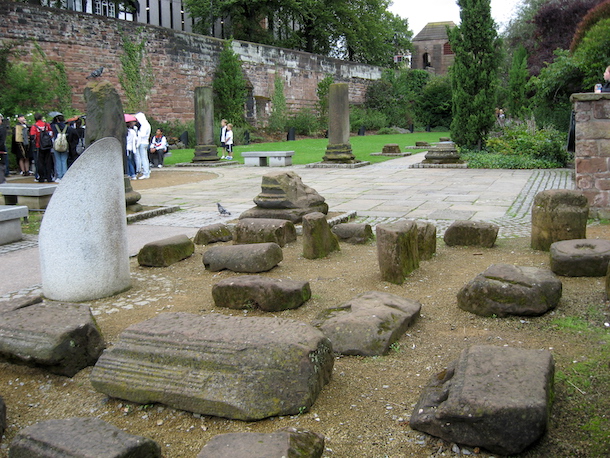
The City Wall running along the Roman Gardens bears some relatively recent repairs to the medieval structure which are of interest. If you look closely, repairs can be seen to the stonework of the medieval wall. The un-weathered masonry marks the site of a breach, battered through the wall by Parliamentary cannon, when Chester was besieged during the Civil War. By September 1645, Chester's loyal stand for King Charles I was nearing an end. The suburbs had been taken. The Royalist garrison and all the citizens took refuge inside the City Walls. Parliamentary troops mounted cannon at St. John's Church, just to the east of where the Roman Gardens are now sited, and bombarded the South Eastern defences. On Monday 22nd September this area of the walls were attacked from 12 noon until 4pm. Thirty-two shots were fired, making a breach wide enough for ten men abreast to enter. Two Royalist soldiers were killed trying to fill the hole with beds and woolpacks. That night, the Parliamentarians tried to storm the breach, but were beaten back after fierce fighting. Hearing of the city's plight, King Charles I arrived in Chester with a force of cavalry on 23rd September. The next day, his army was decisively defeated at the battle of Rowton Moor, one of the turning points of the Civil War. The siege of Chester continued. Although the walls were breached in other places, the Parliamentarians failed to enter the city until Chester surrendered in February 1646.
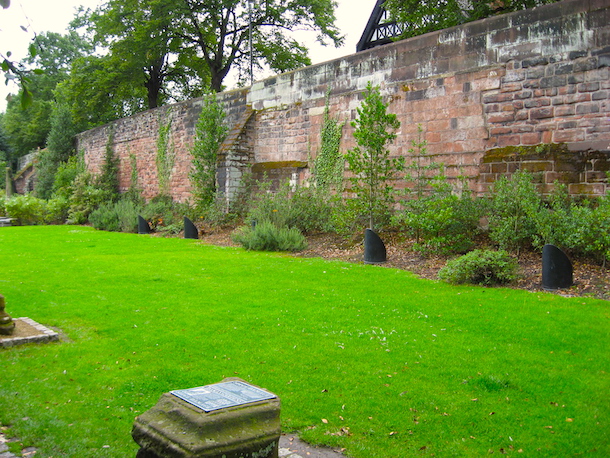
The site of the Roman Gardens was previously occupied by a clay tobacco-pipe factory which was in production from at least 1781 until 1917. The foundations of a brick building have been found alongside the City Wall which runs to the east of the Gardens. Chester was the centre for a flourishing clay tobacco-pipe industry. Chester's pipes were exported in great quantities. The earliest clay tobacco-pipe kiln ever found in Britain has been discovered in Chester.
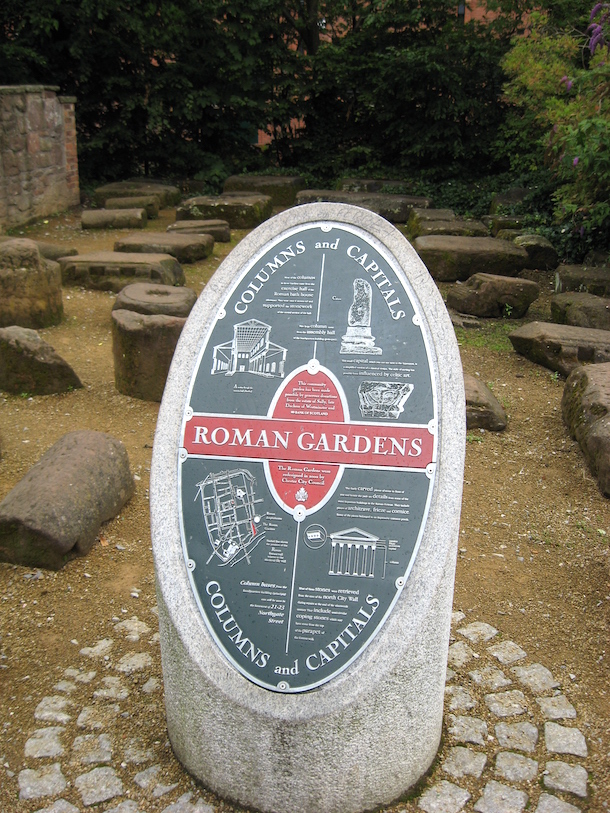
Tobacco first arrived from America in the time of Queen Elizabeth I, over 400 years ago. Smoking became popular at all social levels. Men and women smoked clay pipes made from fine white clay which, like pottery, had to be fired in a kiln. The kiln on the Roman Gardens site was one of the last to produce clay tobacco-pipes in Chester. It closed during the First World War, when cigarette smoking became fashionable. Pipe-makers often stamped their names or initials on the pipes. Clay tobacco-pipe fragments have been found with the marks of three pipe-makers known to have worked from the Gardens site: Joseph Fitzgerald (c 1814-1840), John Jones (c 1818-1869) and William Boynton (1871-1917).
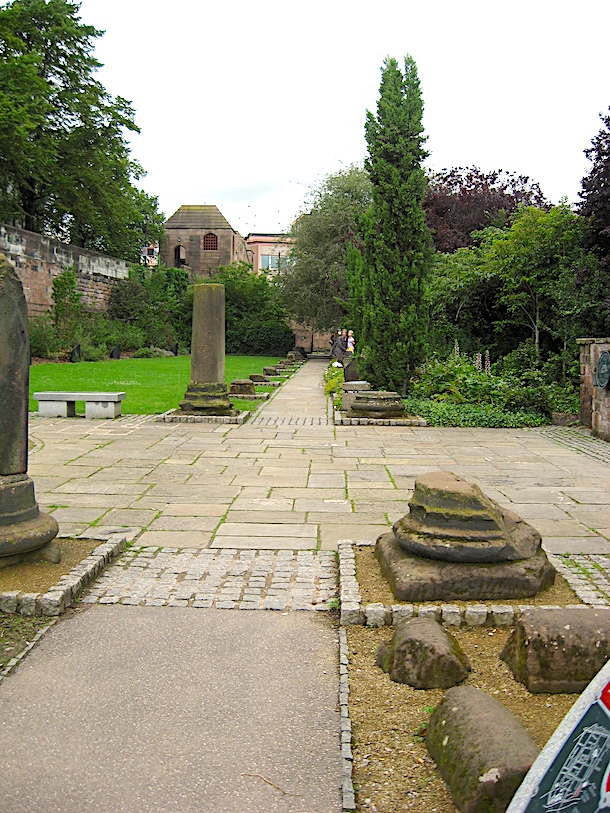
The Roman Gardens also houses a reconstructed hypocaust which was the Roman system of under floor heating. An under floor cavity was filled with hot air from a furnace to heat the rooms or baths above. Several hypocausts have been found in excavations in Chester. The hypocaust in the Roman Gardens has been reconstructed using the pillars (pilae) recovered in 1863 from one of the rooms in the main bath building (thermae) of the Roman fortress. The bath building was one of the most impressive buildings of Roman Chester. Built in AD 75, it measured 85 meters square and used the most advanced building and heating technology of the day. Its walls were over a meter thick and were made of stone faced concrete. It had extensive under floor heating systems (hypocausts) and mosaic floors, and was roofed with sophisticated barrel vaults. Thought to have been a luxurious club for officers, the bath building consisted of three large bathing halls which were supplied with hot and cold running water from Broughton by an aqueduct. They were the cold room (frigidarium), the hot room (caladarium), and the warm room (tepidarium), the first two of which had plunge baths. There was also a courtyard and an exercise hall, columns from which can now be seen in the Roman Gardens.
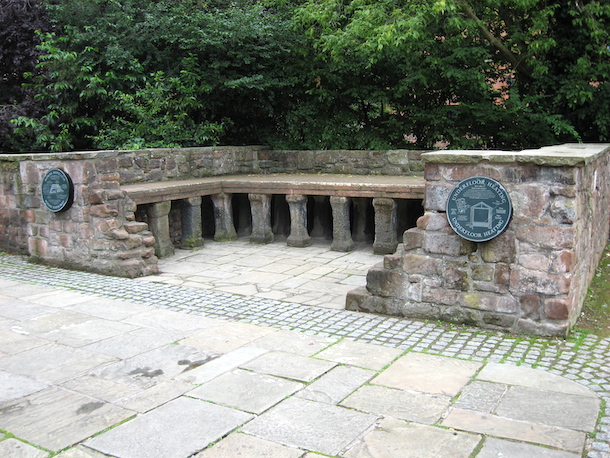
Most of the columns that can be seen in the Roman Gardens came from the exercise hall of the Roman bath house (thermae). They were once 6 meters tall and supported the stonework of the central section of the hall. The largest column currently in the Roman Gardens came from the assembly hall of the headquarters building (principia). Column bases from the headquarters building (principia) can still be seen in the basement of 21-23 Northgate Street. Most of the other stones on view in the Roman Gardens were retrieved from the core of the north City Wall during repairs at the end of the nineteenth century. They include semi-circular coping stones which may have come from the top of the parapet of the fortress wall.
